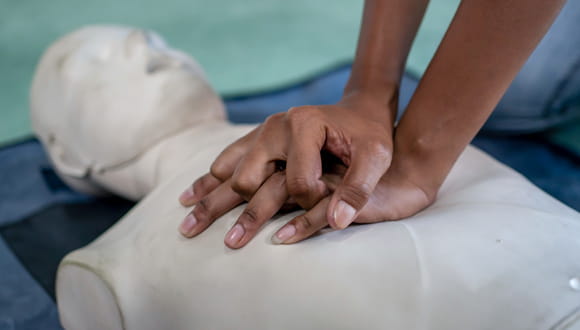How to Perform CPR — A Lifesaving Technique Everyone Should Know
March 20, 2023 - Katie McCallumOf the more than 300,000 cardiac arrests that occur outside of the hospital every year, about nine in 10 lead to death, according to the CDC. Most of those occur at home and can strike without warning — sometimes even in young and/or seemingly healthy adults.
It's why Dr. Kevin Lisman, a cardiologist at Houston Methodist, says being able to provide emergency life support isn't just important for first responders and other medical professionals. It's critical for everyone to know when and how to perform CPR.
"Being able to provide CPR until medical professionals arrive can absolutely be life-saving," says Dr. Lisman.
What is CPR?
CPR stands for cardiopulmonary resuscitation. It's an emergency technique used when a person's heart stops beating.
"When the heart develops a severe arrhythmia that causes it to beat inefficiently, disrupting its ability to pump blood effectively, it's called cardiac arrest," explains Dr. Lisman. "This is a medical emergency. When the brain, lungs and other vital organs aren't getting adequate blood flow, it leads to loss of consciousness and breathing, organ damage and injury, and, ultimately, death."
In fact, death can occur in minutes if life-saving care isn't provided.
(Related: What Cause Cardiac Arrest?)
During CPR, chest compressions help manually pump blood — and oxygen — throughout a person's body until a defibrillator is available. Defibrillators help shock the heart back into a normal rhythm, restoring blood flow.
The CDC states that, if performed in the first few minutes of cardiac arrest, CPR can double or even triple a person's chance of survival, making it a truly life-saving technique.
When to do CPR
How can you tell if a person needs CPR?
If someone around you suddenly collapses, the following signs signal that CPR is needed:
- Unresponsiveness: the person doesn't respond, move, speak, blink or otherwise react after being loudly asked if they're OK and tapped hard on the shoulder
- Lack of breathing: the person isn't breathing normally (only gasping for air) or at all
"For instance, if your neighbor collapses while mowing the lawn and isn't breathing or responsive, call 911 — if people are around you, have someone else call — and immediately begin CPR and continue until medical help arrives," says Dr. Lisman.
Of note, cardiac arrest is different from a heart attack.
"Whereas cardiac arrest is an electrical problem that affects the heart's ability to pump blood effectively, a heart attack is when a blockage in an artery keeps blood from flowing to the heart," explains Dr. Lisman. "A person suffering a heart attack also needs immediate medical attention, but they don't need CPR."
If you or someone around you is experiencing heart attack symptoms — chest pain, shortness of breath, feeling weak, faint or lightheaded, pain in one or both arms and shoulders or in the jaw, neck or back, nausea, fatigue — call an ambulance immediately.
"Heart attack symptoms can progress and lead to cardiac arrest," adds Dr. Lisman. "In fact, heart attack is the most common cause of cardiac arrest. If a person experiencing these symptoms becomes unresponsive and stops breathing, perform CPR until help arrives."
How to do CPR
Medical professionals are formally trained and certified in CPR, but you don't need any special credentials to provide this life-saving care in an emergency.
That said, you do need to be educated and prepared.
CPR training is offered to the general community through both in person and online courses. The American Heart Association also provides videos and other educational resources for performing hands-only CPR. They also have Hands-Only CPR Kiosks set up at airports, convention centers, malls and universities (and more sites) across the country.
If you find yourself needing to provide lifesaving care, here are the steps for hands-only CPR:
- Call 911
- Begin chest compressions: In the center of the chest, push down at least two inches at a rate of 100 to 120 pushes a minute — the beat, for instance, of the classic disco song "Stayin' Alive"
- Continue chest compressions at this rate until the person starts to breathe or move, or someone with more advanced training, such as a first responder, takes over
"Don't be afraid to perform CPR, even if you're unsure you know how to do it correctly," says Dr. Lisman. "When a person is unresponsive and not breathing normally, time is critical. It's always better to try something than to do nothing at all."








